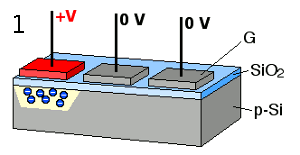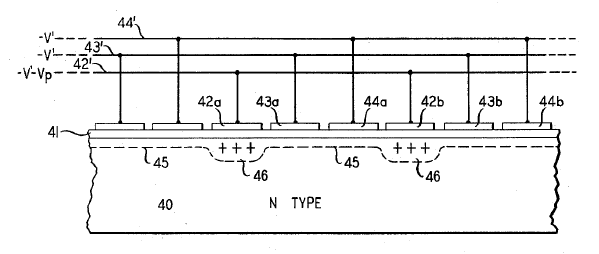Willard Boyle and the CCD
May 23, 2011
Avid readers of this blog may recall that I once worked with
magnetic bubble memories. What they may not know is that the
electronic imaging devices in their
cellphones and
cameras were inspired by magnetic bubbles.
In 1969,
Willard Boyle and
George E. Smith of
Bell Labs noticed their colleagues' work on magnetic bubbles devices which shuttle magnetic domains in a materials using
magnetic fields. They devised an electrical analog of the magnetic devices in which
electric charge was shuttled around by
electric fields. Willard Boyle, who shared the 2009
Nobel Prize in Physics with Smith and
Charles K. Kao, died in his home town of
Wallace, Nova Scotia, Canada, on May 7, 2011, at age 86.[1-5]
Boyle and Smith's invention[6] was the
charge-coupled device, commonly called a CCD. As shown in the figure, application of a voltage sequence at electrodes shuttles electric charge through the
semiconductor material. One application of the CCD was as a serial
memory device, an electrical analog to a bubble memory, but it's most important use was as an electronic imaging device. In the imaging application, there's an additional
photoactive region that produces the charges. In CCD cameras, the image data are stepped out to the edge of the
circuit chip by moving the charge created by the image.

Functional diagram of a basic CCD device. Positive voltages at the electrodes move charge through the semiconductor material.
Images by Michael Schmid, via Wikimedia Commons
CCD cameras revolutionized
astronomy because of their high
quantum efficiency and
linearity. Cameras are not the only devices that were enabled by CCDs. They're used also in
bar code readers,
document scanners,
copiers and
fax machines. In its announcement of the 2009 Nobel Prize in Physics, the Nobel Foundation included the following statement in its press release.[7]
"The CCD ...revolutionized photography, as light could now be captured electronically instead of on film. CCD technology is also used in many medical applications, e.g. imaging the inside of the human body, both for diagnostics and for microsurgery. Digital photography has become an irreplaceable tool in many fields of research. The CCD has provided new possibilities to visualize the previously unseen. It has given us crystal clear images of distant places in our universe as well as the depths of the oceans."
The idea for the CCD came in 1969, in a post-lunch
brainstorming session between Smith and Boyle in Boyle's office. Boyle said that the first model of the CCD idea worked after just an hour's effort.[2] Within a year they had demonstrated a digital camera based on the CCD idea. The device had such possibilities that
Fairchild Semiconductor built a prototype 10,000
pixel CCD imager in 1973. 10,000 pixels is 0.1% the resolution of a typical home digital camera. The camera was in production at Fairchild in 1975, the same year that Smith and Boyle demonstrated a CCD
video camera.

Fig. 4 of US Patent No. 3,858,232, "Information Storage Devices," by Willard Sterling Boyle and George Elwood Smith. The CCD patent was just one of thirteen patents that listed Boyle as an inventor.
Boyle was
Canadian, having been born on Aug. 19, 1924, near the village of
Wallace, Nova Scotia. His parents moved to
Chaudiere, Quebec, when he was three years old.[5] Since the nearest school was thirty miles away, Boyle was
homeschooled by his mother.[1] Boyle's education was all Canadian. He attended
secondary school in
Montreal, and then
McGill University, but his education was interrupted by
World War II. Boyle left McGill in 1943 and became a
Spitfire pilot in the
Royal Canadian Navy. At war's end, he returned to McGill, eventually earning a Ph.D. in
physics in 1950.
After receiving his Ph.D., Boyle worked for a year at the McGill University
Radiation Laboratory, taught physics for two years at the
Royal Military College of Canada (
Kingston, Ontario), and then went to work at
Bell Labs. Boyle spent the rest of his career there, retiring as Executive Director of Research in the Communication Science Division in 1979.
Innovative even before the CCD, Boyle worked with Don Nelson to demonstrate the first continuously lasing
ruby laser in 1962, improving the pulsed ruby laser invented by
Theodore Maiman in 1960. He collaborated with David Thomas on the
semiconductor injection laser.[2] Boyle helped select the
Apollo lunar landing sites.[1]
The CCD invention has made a lot of money for a lot of people. As a commentary on how society values science, the 2009 Nobel Prize in Physics was valued at $1.4 million. Boyle and Smith received half the monetary award, so Boyle's share was $350,000. This, in an era when the
average annual compensation of the
Fortune 500 CEOs was more than $5 million.
As told in the Toronto Sun, Boyle drove a
Mini Cooper with the
license plate, "CCD."[4] Boyle was appointed to the
Order of Canada just last July. In 2005, he was inducted into the
Canadian Science and Engineering Hall of Fame.[4]
References:
- By Thomas H. Maugh II, "Willard S. Boyle dies at 86; a father of the digital camera," Los Angeles Times, May 19, 2011
- Douglas Martin, "Willard S. Boyle, Father of Digital Eye, Dies at 86," The New York Times, May 9, 2011.
- T. Rees Shapiro, "Willard S. Boyle, Nobel Prize-winning physicist, dies at 86," Washington Post, May 9, 2011.
- Sheena Goodyear, "Canadian Nobel laureate dies," Toronto Sun, May 9, 2011.
- Nobel-winning physicist Willard Boyle dead at 86, CTV.ca News, May. 10, 2011.
- Willard Sterling Boyle and George Elwood Smith, "Information Storage Devices," US Patent No. 3,858,232, August 4, 1974.
- "The Nobel Prize in Physics 2009 - Charles K. Kao, Willard S. Boyle and George E. Smith," Nobel Prize Web Site.
Permanent Link to this article
Linked Keywords: Magnetic bubble memory; electronic imaging device; cellphone; camera; Willard Boyle; George E. Smith; Bell Labs; magnetic field; electric charge; electric field; Nobel Prize in Physics; Charles K. Kao; Wallace, Nova Scotia, Canada; charge-coupled device; CCD; semiconductor material; memory device; photoactive; integrated circuit; Wikimedia Commons; astronomy; quantum efficiency; linearity; bar code readers; document scanner; photocopier; fax; brainstorming; Fairchild Semiconductor; pixel; video; US Patent No. 3,858,232; Canadian; Wallace, Nova Scotia; Chaudiere, Quebec; homeschool; secondary school; Montreal; McGill University; World War II; Spitfire; Royal Canadian Navy; physics; Royal Military College of Canada; Kingston, Ontario; ruby laser; Theodore Maiman; laser diode; semiconductor injection laser; Apollo lunar landing sites; executive pay; average annual compensation;Fortune 500; Mini Cooper; license plate; Order of Canada; Canada Science and Technology Museum; Canadian Science and Engineering Hall of Fame.